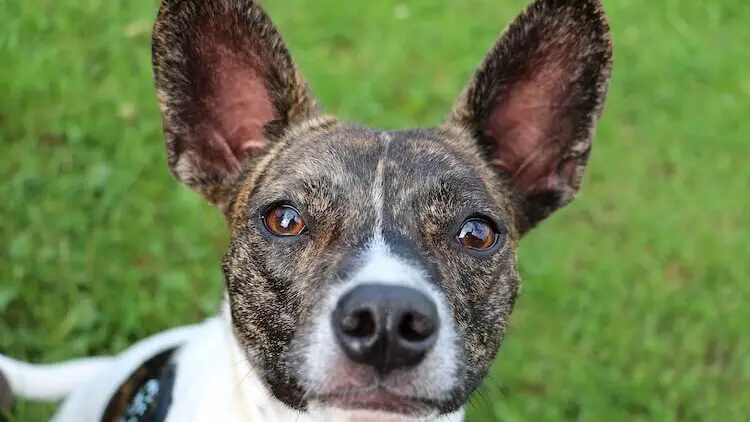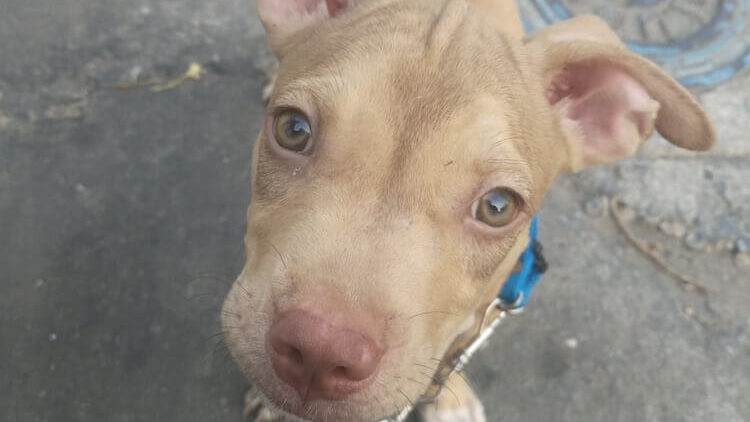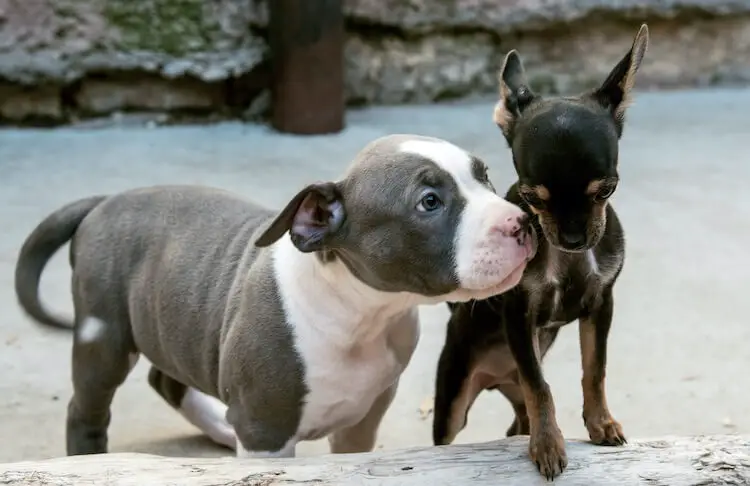Though controversial at times, crossbreeds, mixed breeds, mutts, hybrids, or designer dogs as some call them have become increasingly popular in recent decades. Chipit, Pithuahua, or Chihuahua Pitbull mix is one of the many puzzling crossbreeds that has been getting a lot of attention.
The Chihuahua Pitbull mix is a rare dog that blends the Pitbull’s power and strength with the small Chihuahua’s feisty nature. This results in a compact, small to medium-small but sturdy dog. Because the parent breeds have huge differences, Chihuahua Pitbull mixes range in size, shape, appearance, and personality traits.
The Chipit is a smart, well-balanced, energetic, charming, loveable, fearless but overprotective pooch suited for experienced owners and older children. Chihuahua Pitbulls tend to be suspicious of strangers and other animals, especially other dogs.
They are not recognized by any major kennel club such as AKC but are recognized by registries such as;
- Dog Registry of America, Inc (DRA)
- International Designer Canine Registry (IDCR)
If you have your heart set on the Chipit, get a better feel of this dog’s distinct features, lifestyle, care needs, challenges, cost, etc by Reading On.
Pitbull Chihuahua mix: Overview
| Breed Type | Mixed dog, Crossbreed, Mutt, or Designer dog |
| Height | Females: 12-16 inches, Males: 14-18 inches |
| Weight | Female: 15-30 pounds, Males: 20 to 35 pounds |
| Color Variations | Black, White, Tan, Brindle, Chocolate, Golden, Gray, Brown |
| Temperament | Loyal, Loving, Intelligent, Playful, Affectionate, and can be destructive when bored |
| Purpose | Companion dog |
| Suitable For | Active families |
| Grooming requirements | Moderate |
| Health concerns | Hypothyroidism, Heart problems, Hypoglycemia, Canine allergies |
| Lifespan | 14 to 18 years |
| Other names | Pithuahua, Chipit, Chitbull, Chihuabull, or Mexican Bulldog |
The Chihuahua Pitbull mix is a fairly new crossbreed whose origin remains obscure at best. But to better understand this Chi mix, let’s take a brief look at each parent breed.
Pitbull
Pitbull is not a single breed but a broad term referring to a group of dogs with common ancestry. These dogs are the progeny of Old English Bulldogs and Terriers crosses and include;
- American Pitbull Terrier
- Staffordshire Bull Terrier
- American Staffordshire Terrier
- English Bull Terrier
- American Bulldog
Pitbulls were originally bred to be strong and tenacious for bloodsports such as bull and bear baiting. After the sports were outlawed in the 1800s, their use shifted to illegal dog fighting. Thus, they developed a reputation as aggressive and dangerous dogs due to their past.
It is not uncommon for Pitbulls and their crosses to be dog-aggressive as the trait is passed on. As a prospective Chipit owner, this is something to be aware of since there may be Pit-specific laws, restrictions, and banning depending on your State of residence. Find if there are breed-specific-legislation in your area before committing to this dog.
But since the handlers wanted to control the dogs, they bred them to be human-friendly and easy to handle. This made them calm and loving towards people and incredibly good with children which earn them the name “nanny dogs.”
Over time, the Pitbull’s role changed to hunting, herding, and companionship.
Chihuahua
As a very popular breed with a lot of notoriety, the Chihuahua’s origin is debatable but is believed to be a descendant of the now-extinct Mexican Techichi.
This is one of the smallest dogs bred for companionship. He makes up for his lack of size with a fearless and loving personality but can be feisty, headstrong, cocky, and stubborn.
Most people may struggle with this dog since the experience, proper care, training, and handling skills are essential for this dog.
Chipit Pros & Cons
Pros:
- Compact size
- Intelligent
- Playful, active, and energetic
- Loving
- Loyal
- Adaptable
Cons:
- May have a stubborn and cocky streak thus difficult to train
- Not suited for first-time dog owners
- Can be dog aggressive
- Yappy

Pitbull Chihuahua Characteristics
Height & Weight
The Pitbull Chihuahua mix is a small to medium small dog. He can weigh between 15 and 35 pounds and stands at 12 to 18 inches. This four-legged friend is longer than he is tall.
Most reach their full size in 12 to 18 months.
Appearance:
Being a mixed dog with no breed standard, Chipit’s appearance varies from dog to dog.
But in general;
- They are stronger, stockier, and more muscular than the Chihuahua but not as much as the Pitbull.
- Their heads are slightly rounded with a slightly pointed, medium-sized muzzle and perked-up ears (bat ears)
- They have rounded and far-set eyes that can be dark brown, amber, or blue
- Their tails are medium-sized and may loop up toward their backs
Coat Appearance:
The Pithuahua has a single, soft, low-shedding, and glossy coat.
All of them are short-haired as none of them inherits the Chihuahua’a long coat as the short hair is dominant to the long-haired gene. Two copies of the Long hair gene -from each parent- should be present for a dog to be long-haired. Pitbulls rarely carry the long hair gene or have long hair.
While it is possible to get long-haired Chipits after two or more generations of puppies, none has been observed yet as this mix is quite recent.
Colors:
A Chipit’s coat can be a solid color such as black, blue, chocolate, red, tan, cream, golden or white. The coat can also be a pattern (combination of colors) such as brindle, tan point, merle, fawn, sable, or parti/piebald/white spotted with or without ticking.
Skin, nose, and eye color match with the coat color or the shade of the black color pigment to be specific. The skin can be black, bluish, brown, light brown, or pinkish-to-white spotted matching the nose, lips, and eye rims. Eye color can be dark brown, hazel-green/amber, hazel-blue, or light blue.

Chipit Temperament & Personality
The Chihuahua Pitbull mix’s big personality gets the most attention. He can be affectionate, loving, loyal, sweet, cuddly, devoted, curious, vigilant, fearless, sassy, stubborn, and sometimes needy, moody, timid, feisty, and/or overprotective. He can be hard-headed and strong-willed without firm leadership.
These dogs are big people dogs that thrive on your love, affection, attention, and companionship. They look for happy moments, cuddles, and some love to lick their owners’ faces. But they are not big on being left alone. This is not the dog for you if you work long hours away from home and he is not big on being left alone
This furry friend can be a reliable alarm system. He can be quite vocal attempting to scare off or warn you of the presence of a “would-be intruder” including visitors.
Keep in mind that this pooch can be reserved, suspicious, or in the worst cases reactive to strangers and other dogs, especially if not well-socialized. Early training and socialization can correct and prevent undesired behaviors such as barking, chewing, jumping, and so on. Training and socialization for a social, well-mannered, less snappy, less-reactive, confident, and polite pooch.
Be prepared for an emotional roller coaster in its range, raw form, and richness. The Chipit can pack quite a punch. Of course, each dog is an individual whose unique personality depends on the owner, his hardwiring, his environment, training, and how he is raised. Do not buy this pup on a whim unless you are prepared for this and his needs.
As a Family Dog:
The Chihuahua Pitbull is an adaptable companion and family dog and will adjust to most situations and environments. This pooch will be content with an apartment dweller or a larger space such as a home with a yard or farm- both urban and rural homes if their needs are met.
If you have access to a yard, make it escape-proof. But be aware of any noise restrictions in your area as he can be quite vocal. Training and exercise can keep barking to a minimum but may sometimes be inadequate.
He may be perfect for a seasoned owner and elder individuals and couples that can provide them with love, care, peace, exercise, and consistent training and socialization to dissuade bad behaviors.
Though he is great with older children, this may not be the best dog for toddlers that may be rowdy and play rough. The dog’s natural response may be to growl, bark or nip if hurt. It is important to monitor this dog’s interaction with children as the owner. If you cannot supervise play, keep the toddler and dog separate.
While he can coexist with young kids, this is not the dog for a rough-and-tumble companionship.
Chihuahua Pitbulls with Other Pets:
Although they can get along with other pets such as cats and/or dogs when well-socialized, Chipits prefer to be the single dominant force and only household pet.
It is not uncommon for them to be intolerant of other dogs due to their Pitbull bloodline but get along if socialized from early on. This does not mean that he will attempt to attack any dog he meets but you should take precautions to prevent it from happening through training and proper handling. It is also essential to keep the dog’s safety in mind when dealing with bigger dogs.

Pitbull Chihuahua cost
A Chipit puppy cost ranges from $500 to $1500 depending on the location, breeder, pedigree, and other price factors.
There are also material and long terms costs for things such as;
- Crate/kennel
- Grooming tools
- Collar, harness, leashes
- Spay or neuter procedure
- Feeding
- Training
- Medical expenses
Only buy your pup from a reputable and trusted breeder that is open to visitors for an opportunity to inspect and get a feel for the pup before buying to gauge if you get along. The dogs should be kept in clean, well-cared-for, and spacious conditions.
A reputable breeder can provide medical records for the parents and pups and health guarantees. He or she will ask the right questions such as your dog’s experience, and lifestyle. There should be a return and refund policy on a contract that may or may not include spay and neutering.
Problems can occur with puppies that are separated too early from
their moms and littermates. These pups apparently have not learned
their bite-inhibition lessons, and many professional trainers note
that this early separation seems to cause more issues later with
training. Many Chi pups are not sold until twelve weeks of age. If
you purchased a puppy younger than ten weeks, be aware that you
may have some catch-up work to do in the pup’s socialization and
bite-inhibition work

Care Guide
Routine care and necessities such as puppy proofing, exercise, play, food, grooming, training, and socialization are critical for a dog’s well-being, happiness, and longevity.
Puppy Proofing
Puppy proofing prepares for the pup’s arrival by maximizing comfort and keeping him safe from choke elements, deadly plants, injury, mishandling, and unsafe interactions. It also removes valuable items such as jewelry, shoes, handbags, etc.
Some items that can cause possible harm include;
- Citronella candles
- Fishing hooks, baits, nails, drills, and other possible choke items he may chew on
- Some house and garden plants, compost piles, fertilizer, bioreactors, and so on
- Cleaning solutions and materials
Provide shelter and space with comfortable bedding to shield him from the elements, extreme heat, or cold. Also, limit the time you spend outdoors in cold or hot weather.
Have a high enough fence in the yard or areas he is allowed to keep him from escaping and keep potential threats out of sight. These dogs can be quite deft at digging under fences, scaling over low barriers, squeezing through spaces in the fence, etc. With some foresight, planning, and creative thinking, you can make the yard safer and prevent escape attempts.
Grooming Needs
Since most if not all Chipits are short-haired and only need simple grooming. Grooming keeps the dog in top-notch condition and healthy, create time to bond with the dog, and an opportunity to inspect the dog for injuries and signs of infections such as sores.
This involves;
- Brushing the coat twice or thrice a week with a gentle brush or hand mitt. Begin by brushing against the direction of hair growth then lay the coat in the direction of hair growth. This removes loose, dead hair and dirt, reduces shedding, and distributes natural coat oils to keep it glossy. Brushing also stimulates blood vessels close or on the skin’s surface improving its supply.
- Bathing, rinsing, and drying the coat once a month or after the occasional stinky roll in the dirt, or mud with warm water and the right doggie shampoo. Do not over bath the pooch as this leaves the skin dry, itchy, and flaky. Prevent water and lather from getting into the eyes and ears as you clean the dog. Between baths wipe the coat down using a happened cloth to remove dirt and dead hair.
- Cleaning and drying beddings to remove odor, dirt, and debris while keeping them fresh.
- Dental care by brushing the teeth with a dog-friendly soft toothbrush/finger brush and toothpaste without fluoride for clean, tartar, and odor-free teeth. Also, provide chew toys, dry foods, and chew treats for strong and healthy teeth.
- Ear care by wiping the outer ear portion twice a month using a cotton ball dampened with saline solution starting at the deeper end outwards. Never use cotton swabs or Q-tips and inspect the ears for signs of injury or possible infection such as foul odor, swelling, discharge, irritation, excessive wax substance, etc.
- Keeping fast-growing nails trimmed to improve health, and walking comfort and reduce the risk of injury due to overgrown nails. Be careful not to cut the nail quick where blood vessels and nerve endings reach the nails. Using dog nail clippers, trim the nails away from the quick. The quick is very visible on light-colored nails but not as visible on dark-colored nails. Trim black nails above the pointy end. In case you someday misjudge and cause your do to bleed, apply a quick stop or styptic pen at the end to stop bleeding.
- Inspect the eyes for signs of illness or injury and clean tear stains below the eyes by wiping them using cotton balls dipped in saline solution. Visit the vet in case of any bad signs of eye discomfort, discharge, swelling, or injury.
Your Chipit may develop an attitude toward grooming and should be trained to at least tolerate the process and stay still without nipping or biting. Stay with short grooming sessions with gradual time increments as you reward good behavior while ignoring and correcting bad behavior. Never yell or prolong the session if he is reactive and impatient. Make sure he enjoys the process by making it a positive experience
Exercise Needs
Despite their compact size, the Chihuahua Pitbull mix needs moderate physical and mental stimulation of about 45 minutes per day. This keeps the dog active, improves cognitive ability, and prevents obesity
Without sufficient exercise to burn up pent-up energy, this dog can get bored, and restless, and exhibit destructive behaviors such as chewing, excessive barking, digging, and so on.
Exercise needs can be met through daily walks, the occasional run, tracking, games such as fetch or tug, agility training, teaching tricks, and brain games such as puzzles.
Use a fitting or adjustable flat buckle collar or back-clip harness attached to a 4 to 6-foot nylon or leather leash with a good grip for outdoor play and walks. Never leave your dog unattended outdoors and keep an eye on signs of over-exhaustion such as panting or remaining behind.
| Number of walks | 2 (15 minutes each) |
| Exercise needs | upwards of 45 minutes |
Dietary & Nutritional needs
A high-quality diet is a priority for the Chipit crossbreed that depends on weight, activity levels, metabolism, and age. This can be homemade or store-bought food but not food scraps and some human foods that may be toxic to it.
The food should smell nice, be palatable, bite-sized for ease of chewing, be from high-quality sources and be digestible with less filler
The diet should meet the dog’s calorific and nutritional needs.
Calories:
As a general rule of thumb, each dog needs about 30 calories for every pound it weighs. As such, a Chihuahua Pitbull that only weighs 20 pounds, only needs 600 daily calories. This is about 2 cups of dry food divided into 2 or 3 daily portions.
| Guide | 600 to 1100 calories |
| Cups of Kibble | ~2 |
Schedule your Chipit’s meals at specific times of the day and record the amounts of calories he takes in after each meal. Calorific fluctuations and overfeeding can lead to massive weight gain.
Nutrients:
Nutritional needs are more complex and the most available information comes from ongoing research. The food should include;
- High-quality protein from sources such as turkey, fish, lamb, or chicken. Proteins should make up about 20% of the diet
- About 7% fats to meet the dog’s energy needs. Increase the amount of fat in the cold winter months
- Carbs and fibers for energy and satiety
- Vitamins from vegetables and fruits such as carrots, bananas, blueberries, peas, and so on
- Trace amounts of approved minerals such as calcium, zinc, phosphorous, sodium, potassium, etc.
Stay away from foods with artificial additives, colorings, fillers, and by-products as they may upset the dog’s stomach.
Only supplement the diet under the direction of your Vet as too much of a good thing can be bad.
Also, provide a constant supply of clean water at all times to keep the dog hydrated
Food types:
Commercial foods should be AAFCO approved or labeled Complete and Balanced. Store-bought foods can be dry, semi-moist, wet, or canned.
Dry foods are inexpensive and have a long shelf life but tend to have higher amounts of preservatives. Semi-moist foods have a shorter shelf life, fewer preservatives, and higher amounts of sugar.
Wet or canned foods have the least amount of preservatives and sugar but are the most expensive. Semi-moist and moist foods are very palatable and can cause a dog to overeat but rarely overeat kibble unless there is perceived food competition.
Homemade foods are free of preservatives, chemicals, and artificial coloring. These foods can be prepared from organic whole grains, cooked meat, vegetables, minerals, and other important but approved nutrients.
Only prepare homemade foods with precise measurements from the recipe developed by a nutritionist. Some online resources also offer healthy and tasty homemade dog recipes for foods and treats. Safe handling and hygiene are critical when making homemade foods.
4. Training & Socialization
The Chihuahua Pitbull mix is a smart, eager-to-please, and trainable dog but training is not an easy task. Your training approach has the biggest impact on your success rate. Positive reinforcement, reward-based training, and markers have been shown to achieve the best success.
Reward desired behavior to reinforce them (operant conditioning) while ignoring and correcting undesired behavior to shape his overall behavior. Be patient, calm, dedicated, and consistent, be firm with training, and set boundaries so the Pithuahua does not rule over you. Do not let the dog get away with behaviors such as jumping at people or compulsive baking as they are self-reinforcing.
Start house training and crate training as soon as the dog gets home.
Food rewards, toys, and verbal praise are great motivators for most dogs including Chipits, and can be withheld to fine-tune certain movements, correct certain behaviors, and so on. Reward the dog when he performs a correct action or behavior.
Also, food lures are handy when teaching tricks such as walking to heel, staying, sitting, jumping, and the like.
Training is a long-term process that does not achieve overnight results. Several repetitions are needed to teach certain, tricks, commands, and correct undesired behaviors. Conversely, set realistic training expectations.
Socialization:
Early and consistent socialization dissuades the dog from bad behaviors such as chasing, nipping, and incessant barking and makes him more welcoming of others
Once fully vaccinated, the pup must be introduced to all kinds of people- tall, short, young, old, bikers, etc-.
Socialization with other animals and vaccinated dogs are of equal importance. When walking past other dogs, stay within the Pithuahua’s comfort zone, keep the dog close to you on a loose leash and pay attention to his reaction. Reward and praise her for being calm and for paying attention to you
Socialization makes the dog trustful and accepting of people and other animals
Pitbull Chihuahua Health Concerns
Although this is a fairly healthy mixed breed, he is susceptible to health complications such as;
- Teeth problems
- Hair loss
- Heart problems
- Eye complications
- Allergies
- Pregnancy problems
Adhere to vaccination and medical examination schedule for check-ups and tests from a qualified vet to detect issues early. Another great recommendation is to sign up for pet health insurance to cover some medical costs
Lifespan:
The Chihuahua Pitbull mix has a long lifespan of between 14 and 18 years. Life expectancy depends on diet, exercise, health, lifestyle, and so on.
Is Chipit a good dog?
The moral of this article is that the Chihuahua Pitbull mix can be an incredible pet in the right hands. This dog is quite versatile and can adapt to many lifestyles and homes as long as its needs are met.
However, do not let the designer dog appeal get in the way of choosing a healthy and well-tempered pup. In addition, do not let negative connotations dissuade you from getting this dog. Ensure you can meet the dog’s needs and that your lifestyle is the right fit for him before buying or adopting
Also, remember to research local laws as some areas have breed-specific legislation (BSL) and possible restrictions on Pitbulls and their mixes.
Did you find this guide helpful? Share your feedback and questions in the comment section below.
There you go, WOOF!

